Eargo 7 Review and Pricing
Based on our testing experience, the Eargo 7 offers advanced OTC technology, discretion, and a useful mobile app.
SeniorLiving.org is supported by commissions from providers listed on our site. Read our Editorial Guidelines
Eargo sells over-the-counter (OTC) hearing aids for people with mild to moderate hearing loss. The Eargo 7 is the company’s most advanced model. Like all OTC hearing aids, the Eargo 7 is not designed for severe or profound hearing loss.
The Eargo 7’s extensive features, useful mobile app, and discreet design make it one of the best hearing aids for users who want a high-tech OTC device. Eargo kindly provided me with a sample to try out; I’ve been reviewing hearing aids for SeniorLiving.org for years, so I was excited to get my hands on this new model. For this review, I unboxed, set up, and wore the Eargo 7s to evaluate their price, convenience, and function. I also consulted with our resident audiologist, Dr. Ruth Reisman, for her insights on these devices. Below, we’ll get into my findings.
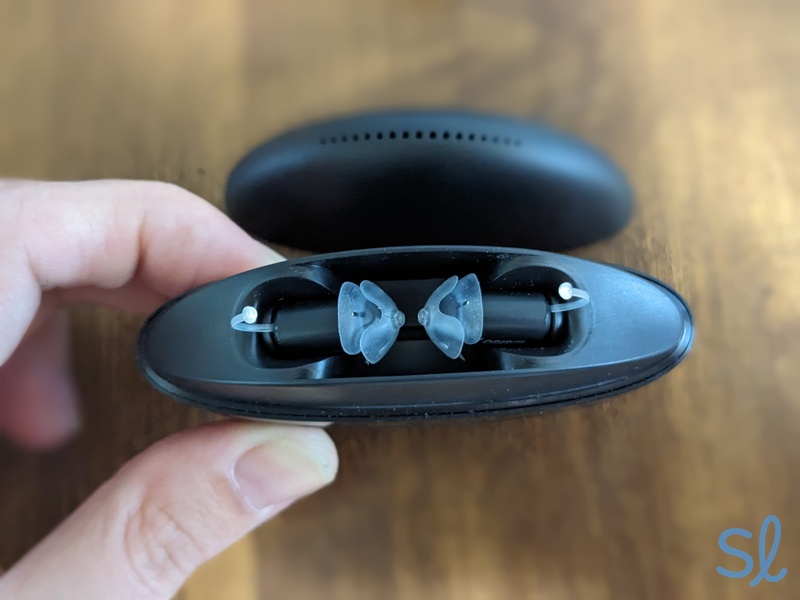
Eargo 7 devices in the portable charger.

Pros About Eargo 7
- Virtually invisible
- Easy to set up with the mobile app
- New Sound Adjust+ feature automatically optimizes soundscape
- Portable charging case for up to two days of on-the-go charging
- Up to 16 hours on a single charge
- In-app SoundMatch hearing test for customized hearing profiles
- Free in-app video calls with Eargo specialists (only during business hours)
- Lifetime, professional support
- 45-day return policy and free returns
Cons About Eargo 7
- May not fit all users, depending on ear canal shape and anatomy
- Not Bluetooth compatible; no streaming
- Must have a smartphone to use
- Must purchase in pairs
- In-ear indicators are very loud
- Double-tap program change function is unreliable
Unboxing and Setup for Eargo 7
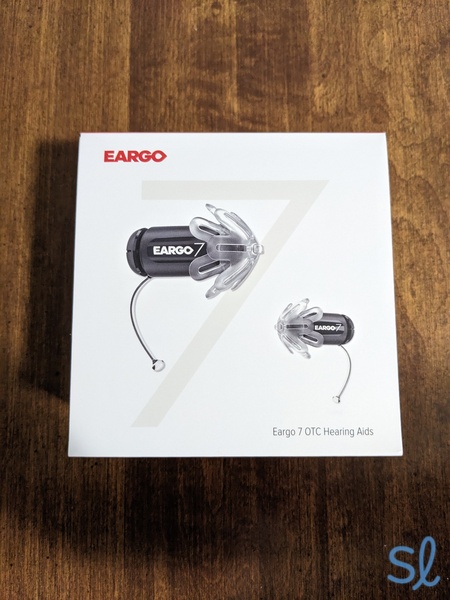
Eargo 7 packaging
Unboxing Eargo 7
Eargo sent me a pair of Eargo 7 hearing aids to test out. The packaging is crisp and sleek — it felt very much like opening a present! Best of all, it offered instructions as you opened the package so that you knew what everything was and what to do with it.
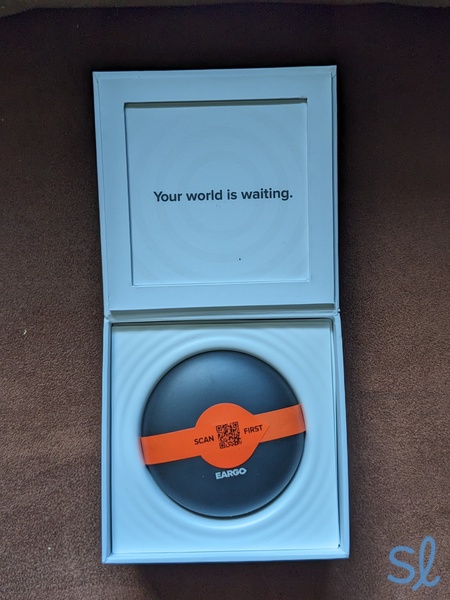
Eargo 7 unboxing reveals a QR code to scan.
I followed the instruction to “SCAN FIRST” before continuing. I used my smartphone’s camera app to scan the QR code. Then, I clicked on the link that popped up. This will bring you to the Eargo website, where you must register your device. If you don’t register your Eargo 7s, you can’t connect them to the mobile app later on.
Did You Know? Sixty-one percent of adults ages 65 and up own a smartphone. You’ll need to be one of them if you plan to use Eargo. The Eargo 7 requires a smartphone for self-fitting and adjustments.
Here, you can also create an account and provide your contact information if you’d like to schedule an orientation call.
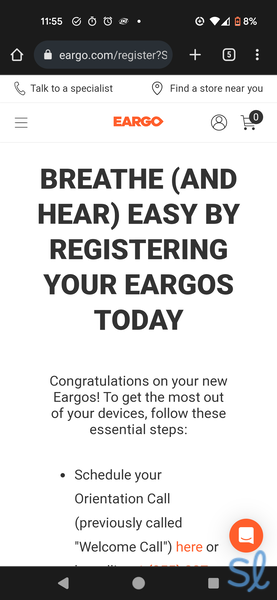
Eargo 7 welcome and registration mobile website screenshot
I grabbed the charging case so I could test out the devices. I was met with further instructions to charge the Eargo 7 for at least four hours before continuing with setup. Then, I opened up the rest of the package.
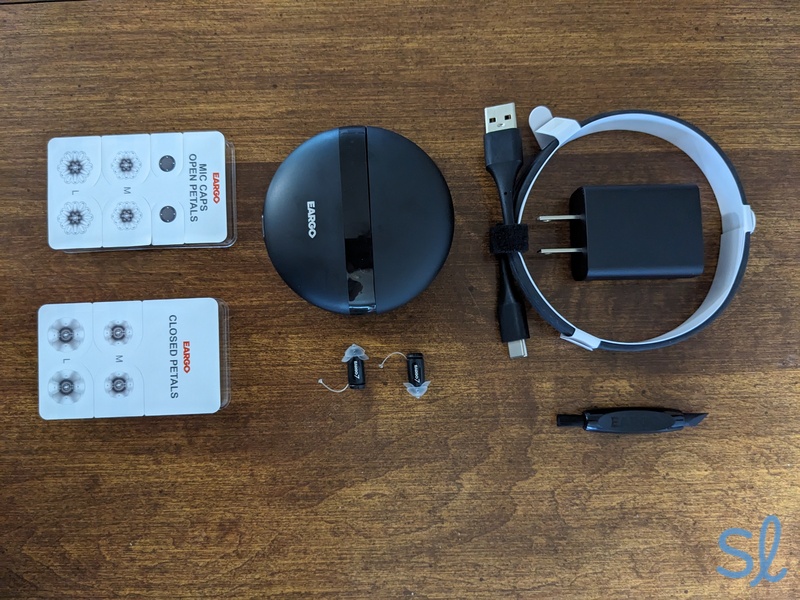
Everything included in the Eargo 7 box
Here’s what’s included in the Eargo 7 box:
- Two Eargo 7 hearing aid devices
- One portable charger
- One USB adaptor
- One USB cord
- Two medium and two large open-ear tips
- Two medium and two large closed-ear tips
- Two microphone caps
- One cleaning cloth
- One cleaning tool
Eargo’s accessories are clearly labeled and easy to use. The most impressive accessory by far is the charging case. My prescription Oticon hearing aids didn’t even come with a portable charging case like this one. Its slim yet rugged design stores your hearing aids when not in use and carries up to two full charges. A magnet holds each hearing aid in place, and the cap attaches magnetically. The whole kit fits easily into your pocket or purse.
Charging Eargo 7
Charging the Eargo 7 is simple. I placed the hearing aids back in the portable charger and then plugged everything in. The charging port and battery indicator lights illuminate for a few seconds after you close the case. This visual indicator is a major plus if you need to plug them in at night or have poor eyesight.
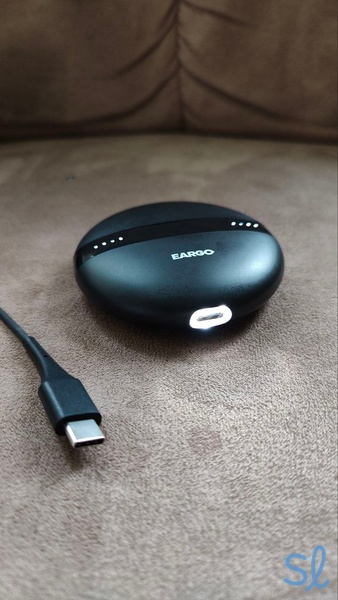
Eargo 7 charging case with light-up USB-C port
It takes six hours for the Eargo 7 hearing aids to fully charge, and the devices are estimated to last up to 16 hours of consistent use on a single charge. Plus, the portable charging case holds an additional two charges—great for weekend getaways!
Did You Know?The average lifespan of a rechargeable hearing aid battery is five years. To prolong battery life, experts advise against letting your hearing aids go completely dead.
Downloading the Eargo App
While my devices were charging, I downloaded the Eargo app. You can download the application in two ways: through the QR code that comes with the hearing aids or by searching “Eargo” in the App Store or Google Play Store. The Eargo app is only compatible with mobile devices running Android 7 or later and iOS 13 or later. If you need to upgrade your phone, check out our top smartphone picks for seniors.
>> Related Reading: The Best Apps for Older Adults in 2025
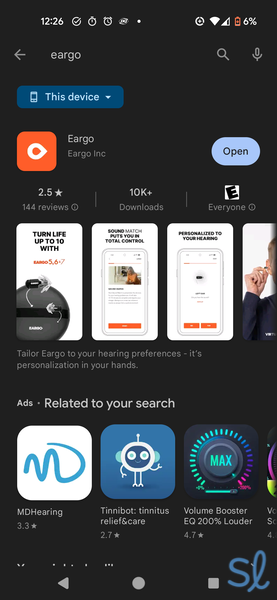
Screenshot of Eargo app in the Google Play Store
Connecting Your Eargo 7 Devices to the Eargo App
Next, I grabbed the charging case, which still had the hearing aids inside, and opened up the newly- installed app. It was simple to follow the on-screen prompts to connect the hearing aids to the app. The process took about six minutes — most of which was spent updating the device settings. I had to align the charger next to my phone until the updates were complete.
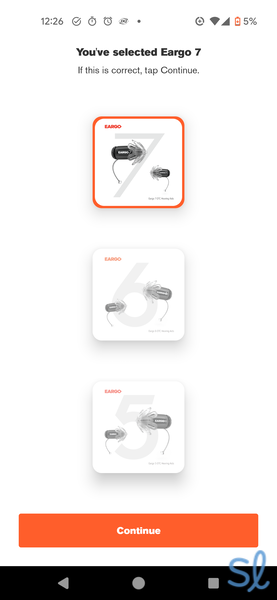
Choose the correct model for set-up
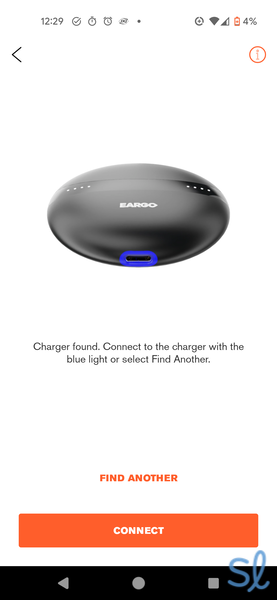
Charger lights up blue when pairing to your phone
Testing Out the Eargo 7
Finally, it was time to take these hearing aids for a spin!
Fitting the Eargo 7 Hearing Aids
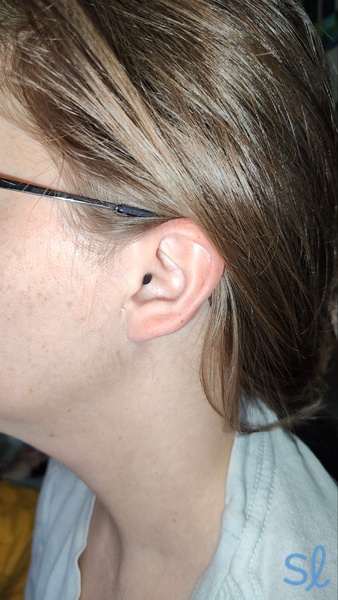
Yes, I’m really wearing the Eargo 7 in this picture!
The Eargo 7s are self-fitting completely-in-canal (CIC) hearing aids. They’re practically invisible when fitted properly, making them a great choice for users who want to keep their hearing aids hidden. You just press them into your ear canal, leaving the clear device removal thread accessible. Eargo used this CIC design to make the user experience as discreet as possible.
Since I have very small ears, the Eargo 7 devices did not fit my ears well. They caused some pain and discomfort. Eargo sends along other petal sizes to accommodate different ear sizes, but only medium and large. I chatted with Jasmine from Eargo’s web chat customer service to find out if there were other petal sizes available. Unfortunately, Eargo doesn’t offer anything smaller.
FYI: Unsure if your hearing aids fit properly? You can always schedule a free video call with an Eargo hearing professional within the app. You can also check out our in-depth look at properly putting in and removing your hearing aids.
The device itself is lightweight and small compared to other hearing aids on the market, but it won’t work for all ear shapes and sizes. If you have small ears like me, the Eargo 7 design may impact your experience, and a behind-the-ear (BTE) hearing aid might feel more comfortable. Check out our top BTE hearing aids for some ideas.
Setting Up Sound Match
You can use the Eargo 7s as-is, or you can self-fit them to your hearing and listening needs by using Sound Match. The in-app Sound Match hearing test took me about 20 minutes. You need to be in a quiet environment for the duration of the test.
The app tests your hearing one ear at a time. You just press YES or NO to indicate whether you heard the sound being played. Eargo stores your session in the app so that you can apply the hearing profile. You can retest as often as you’d like, and the app stores your previous three sessions.
The test was more thorough than other online hearing assessments I’ve tried. But I couldn’t compare it to my actual audiogram because you’re not given access to the results. That being said, the hearing aids worked more effectively after I used Sound Match than they did when I was just using a preset program.
Because all of Eargo’s hearing tests and adjustments are made through the app, Eargo 7 is best for those who don’t care about in-person adjustments nor customizations with an audiologist. If you have mobility issues, or live in a rural or remote area where audiologists are in short supply, this may be a great option for you.
Changing Programs and Making Adjustments
After setting up Sound Match, you can customize Eargo 7 to suit your needs in different environments. Eargo 7 hearing aids don’t have built-in volume or program buttons. Instead, you can adjust the program and volume with the Eargo app or by double-tapping near your ear. This design choice is excellent for those who want to make adjustments via their smartphone instead of fiddling with tiny device buttons.
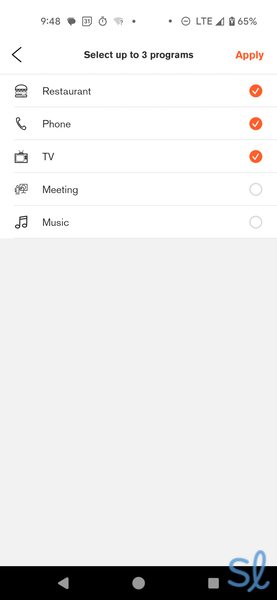
You can choose up to three programs to rotate through (plus the Normal setting)
Using the app to change programs was simple. Make sure you hold your phone up in front of your face as you make changes. The phone makes a noise that cues the hearing aid to switch to your desired program, so it needs to be close by. When the change is successful, you’ll hear the name of the program spoken into your ear. For example, if you click the “restaurant” program, you’ll hear “restaurant” in each ear.
Unfortunately, the double-tap function was fairly unreliable for me, and this design feature may be difficult for wearers to use. In theory, you should be able to quickly double-tap on or near each ear to switch to a new program. I had very little success getting the hearing aids to change programs. I found tips on the Eargo website, watched a YouTube video made by Eargo, and chatted with customer support. Eargo suggests several ways to make the double tap program change work. However, none of the methods worked consistently for me. I preferred using the app.
Pro Tip: Adjusting to new hearing aids typically takes 30 days. Until you’ve adjusted, your voice might sound tinny or unnatural. Eargo’s 45-day trial period gives you the time you need to adjust and decide if Eargo meets your needs.
It’s also worth noting that the in-ear indicators (like “restaurant” or “normal”) are very loud — sort of like someone shouting in your ear. I chatted with Jasmine again to ask about a way to adjust the volume for these in-ear indicators, but there isn’t one. The hearing aids make loud in-ear noises whenever you adjust the hearing aid volume, change the program, or hit the max or minimum volume level. This might not be a deal breaker, but it’s just something important to be aware of.
Need Help Finding the Right Hearing Aid?
Answer a few easy questions to find the hearing aid that’s right for you.
Eargo 7 Price
The Eargo 7 is Eargo’s top-of-the-line model — with a price tag to match. Unlike MDHearing and some other OTC brands, Eargo hearing aids are only sold in pairs. A pair of Eargo 7 hearing aids costs $2,699, though Eargo runs frequent sales. For comparison, the Eargo SE costs $1,699 and the LINK by Eargo costs $799. The additional $700 for the Eargo 7 will buy you better moisture and sweat protection, Sound Adjust+ with clarity mode, and a two-year warranty.
>> Related Reading: Eargo vs. MDHearing Guide
While nearly $3,000 might seem pricey for a pair of hearing aids, keep in mind that prescription hearing aids can easily cost $3,000 per hearing aid. Plus, the Eargo 7 offers more advanced customization features than cheaper OTC hearing aids we’ve tested, such as MDHearing. The convenience and technology backs up the higher price tag.
Your purchase price also includes all of the accessories you need to get started. Plus, you’ll receive access to lifetime support from Eargo’s hearing professionals. You can schedule free video calls within the mobile app for virtual face-to-face support. For comparison, Lively, another top OTC provider, only offers three years of follow-up care. You can read our Lively hearing aid review to compare these two companies further.
Eargo Mobile App Experience
Eargo’s mobile app is essential if you want to use Eargo 7, and I was very impressed with the app! It’s designed to be simple and informative, making the user experience as smooth as possible. It’s easy to navigate and full of helpful tutorials, videos, and tips. Eargo went above and beyond making it user-friendly, especially for those who aren’t smartphone savvy. Plus, you can easily see your charger’s battery level.
Let’s take a look at what you can do within the app.
Watch Video Tutorials
The app features 12 video guides to walk you through fitting, removing, and charging your hearing aids, changing the petals, and more.
Watch the videos as you need them, or go through Eargo’s 30-day tutorial. This tutorial suggests watching certain videos each week over four weeks so that you’re not overwhelmed with information.
Read the User Guide
You can read the full Eargo 7 user guide in the app, too. Enjoy step-by-step written instructions with pictures and diagrams. This is a great alternative to watching videos if you learn better by reading. Find out how to fit, clean, and care for your hearing aids.
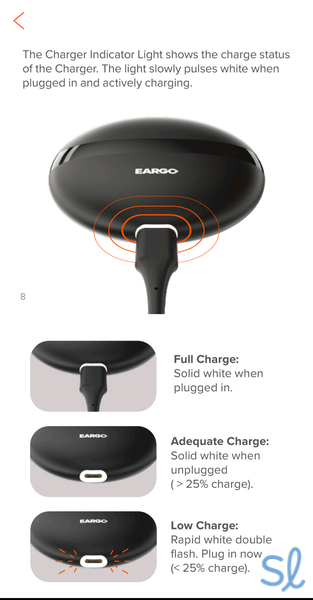
Screenshots of the charging page in the Eargo 7 User Guide
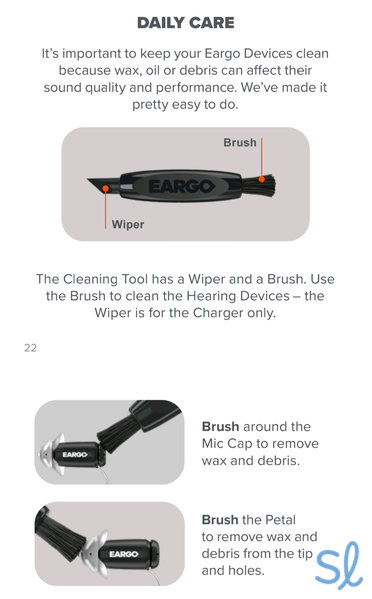
Screenshots of the cleaning page in the Eargo 7 User Guide
Change Programs and Adjust Volume
Eargo gives the user a lot of control over their devices. You can adjust the volume, choose to amplify voices, switch programs, and more, all within the app.
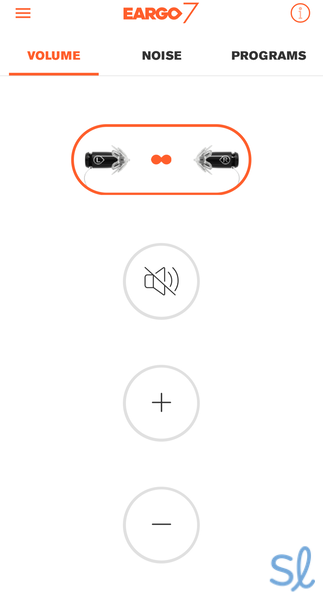
Adjust the Eargo 7 hearing aids’ volume individually or together
You can even customize individual programs by adjusting the volume, treble, and bass.
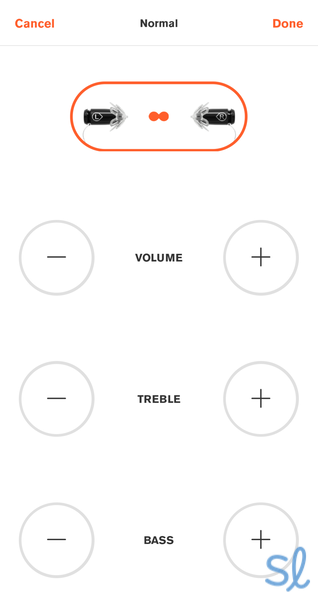
Customize preset programs
You can also make temporary adjustments based on your hearing needs and the surrounding environment. Adjust how much noise gets filtered out, emphasize speech as needed, or let your hearing aids automatically adjust to your environment. I was really impressed with how much Eargo lets the user do. I could notice a clear difference as I changed programs and adjusted settings.
Manage Reminders
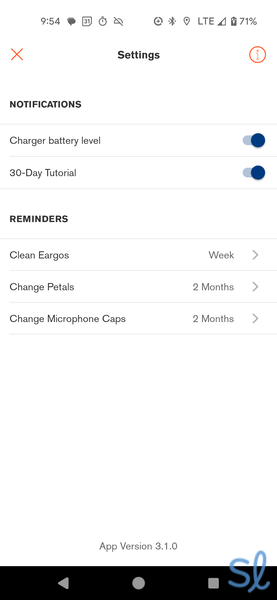
Choose what reminders and notifications you’d like to receive
You can set up reminders so you don’t forget to change your petal tips, change your microphone covers, or clean your Eargo 7 devices. You choose the frequency. I often forget to do this with my own pair of hearing aids, so I like that this feature is built right into the app. Plus, each reminder has a link to a video showing you how to do the task.
Contact Eargo Support Professionals
You definitely aren’t on your hearing aid journey alone when you choose Eargo. The mobile app makes emailing, chatting, calling, and video calling with Eargo professionals a breeze. Support is available during business hours.

I found their customer service team to be very helpful. I did have to wait for a response on the web chat for around 40 minutes, but it was a Friday near the end of business hours. I like the option of scheduling a video call — that way you can pick a time that works for your schedule with no waiting on hold.
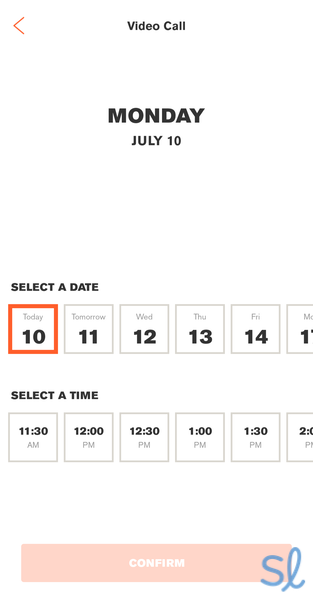
Schedule a Video Call with an Eargo Hearing Professional within the app
When I evaluated the app, there was an appointment slot available within 90 minutes that I could sign up for! You’d have a hard time getting in to see your audiologist in person that quickly — so getting that support when you need it from wherever you are is a major plus.
Eargo App Drawbacks
The biggest drawback with the Eargo mobile app involves the hearing aids themselves. Except for the LINK, Eargo hearing aids aren’t Bluetooth-connected, your smartphone needs to communicate with them using different tone frequencies. That means you need to have your phone volume turned up to at least 60 percent. Eargo reminds you of this when you open the app. If you put your phone on silent, do not disturb, or turn the volume down, you won’t be able to use the app to adjust your Eargo 7 devices.
If Bluetooth streaming is important to you, I’d recommend Jabra Enhance. All of their models have Bluetooth features and some even feature hands-free calling.
How Eargo 7 Stacks Up Against the Competition
Do you know you want an OTC option but aren’t sure which one will be best for you? Here’s how the Eargo 7 stacks up against similar OTC hearing aids:
| Eargo 7 | Jabra Enhance Select 500 | MDHearing NEO XS | Audicus Spirit 2 | |
|---|---|---|---|---|
| Style | CIC | BTE | CIC | Receiver-in-canal |
| Price Per Pair | $2,699 | 1,795-$1,995 (based on package) | $397 | $1,648 (rechargeable is $50 more) |
| App Connectivity | Yes | Yes | No | Yes |
| Battery Type | Rechargeable | Rechargeable | Rechargeable | Battery powered or rechargeable |
| Audiologist Access | Yes | Yes | Yes | Yes |
| Bluetooth Streaming | No | Yes | No | Yes |
If you’re interested in a discreet, in-ear hearing aid — and you have some wiggle room in your budget — the Eargo 7 is a great option. It has advanced features and an excellent mobile app. On the other hand, maybe technology isn’t your strong suit. Or, you don’t own a smartphone, are on a tight budget, or are looking for a different style of hearing aid. In that case, we’d recommend checking out other popular OTC brands like MDHearing and Jabra Enhance.
For a closer look at how these brands compare, visit our list of the best OTC hearing aids.
Our Methodology: How We Tested and Reviewed the Eargo 7
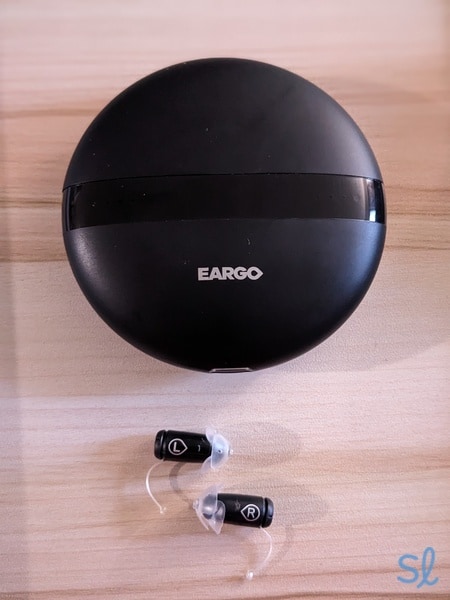
Testing out Eargo 7 hearing aids
I unboxed, set up, and wore the Eargo 7s for a week. During that time, I assessed ease of use, sound quality, rechargeability, and adjustability. I used the Eargo app extensively and spoke to Eargo customer service representatives and sound specialists. I also compared the Eargo 7 to other OTC and prescription hearing aid brands to assess their viability for seniors with hearing loss.
Here’s what my testing process looked like:
- First, I researched Eargo 7 hearing aids online. Then, I requested a pair from the company to try out.
- Upon receiving the hearing aids, I reviewed the external and internal packaging. I unboxed the hearing aids and set them up according to instructions — taking note of how easy (or difficult) the process was.
- I charged the hearing aids and timed the process so that I could provide our readers with precise information regarding what to expect.
- Then, I downloaded the Eargo app and synced it to my mobile device. I connected the hearing aids to the app and timed the process. Once the app was paired with my devices, I tested all of its features — including the SoundMatch hearing test.
- Once everything was ready to go, I wore the hearing aids for a week. I tested them at home, while running errands, on walks, and during other activities. During that time, I used the app to make sound adjustments and test programs.
- I reached out to customer support with any questions I had or when I needed assistance.
Based on my hands-on experience, I evaluated the Eargo 7s using the following categories:
- Price and value: Eargo 7 hearing aids fall somewhat on the higher end of the OTC price range. However, they are significantly less expensive than comparable prescription hearing aids. I noted any seasonal promotions, assessed the hearing aid’s value, and compared them to other similar OTC brands.
- Size and discretion: Eargo 7 hearing aids are discreet, small, and practically invisible when worn. I compared them to other small or technologically advanced hearing aids to gauge the differences in features like Bluetooth connectivity.
- Battery type and battery life: The Eargo 7 runs on rechargeable batteries. Battery life and ease of use are important features for seniors to consider. So, testing out Eargo’s battery life and charger case was important.
- Sound quality: After using my Eargo 7’s in various environments, taking the SoundMatch test, and adjusting the settings as needed, I assessed their sound quality. I also compared them to my experience with other OTC brands.
Final Thoughts on Eargo 7
Overall, Eargo 7 packs impressive technology into a tiny device. These hearing aids offer more customization options and in-app adjustments than other over-the-counter hearing aids we’ve tested, such as Lexie, making them an excellent option for those with mild to moderate hearing loss. I do wish the double-tapping feature worked better, but the easy-to-use app more than makes up for it.
Plus, the Eargo 7 hearing aids do much more than amplify voices. The SoundMatch+ customizes the devices to your specific hearing loss, making it easier to hear and understand people speaking, whether you’re holding a conversation or watching a TV show.
The nearly $3,000 price tag can seem daunting, but if the devices help you hear better and stay safer as you age, it’s certainly worth it. And the 45-day trial period gives you ample time to see if they’re right for you. Just keep in mind that if you have moderate-to-severe hearing loss, have very small ears, or want Bluetooth streaming, you’ll want to look elsewhere.
Read our Eargo review for 2025 for a full look at the company’s products.
Frequently Asked Questions About Eargo 7
-
When did Eargo 7 come out?
Eargo launched Eargo 7 in January 2023.4
-
How long does the battery last on the Eargo 7?
The battery lasts for up to 16 hours on a single charge.
-
Does Eargo 7 have Bluetooth?
No, Eargo 7 is not Bluetooth compatible. You can’t stream calls, music, movies, or other Android or iPhone sounds to your Eargo 7 hearing aids.
-
Do you need a prescription for Eargo 7?
Eargo 7 hearing aids are over-the-counter, self-fitting devices. You don’t need a prescription to purchase them.
-
I’ve used Eargo 7 hearing aids since they came out and used to love them. But, they don’t seem to have as much volume as before. What should I do?
Reach out to Eargo for remote support to adjust your hearing aids. If that doesn’t work, it may mean that your hearing needs have changed. Take Eargo’s online hearing test to see if your results are different than they were when you first got your hearing aids. If so, consider seeing an audiologist for a full evaluation. It may be time to get prescription hearing aids instead of OTC ones.
National Institute on Deafness and Other Communication Disorders. (2021, Mar 25). Quick Statistics About Hearing.
Johns Hopkins Medicine. The Hidden Risks of Hearing Loss.
Pew Research. (2022, Jan 13). Share of those 65 and older who are tech users has grown in the past decade.
Eargo. (2023, Jan 4). HEARING WELLNESS PIONEER EARGO LAUNCHES EARGO 7, ITS MOST REVOLUTIONARY DEVICE YET, AT CES.


